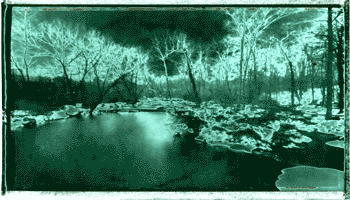

The new process, as yet unnamed, uses the throw away negatives from Polaroid
photographs made with a pinhole camera. The process is deceptively simple. One
makes a normally exposed Polaroid photograph, process it as usual and when done
carefully peel it apart, keeping the intermediate parts from touching the paper
negative. Then hold the paper negative up to the sun. After a few seconds, look
at it; keeping it facing the sun until it has achieved the look you are after.
Carefully tear away the top and bottom bits, making sure you don’t get
any of the goo on your hands or clothes, and place it, face up, to harden. Gently
wash off the hardened paper negative in cold water and let dry.
Scan, modifying only Brightness and Contrast, and print on the paper of your
choice. I prefer to use Hahnemuhle Allegretto paper on an Epson 2200 printer
with Epson Inks.
I spend many, many hours in and around where my school is located in the Appalachian Mountains of Northern New Jersey. The region has a long and varied history of which I am becoming more and more aware. By being somewhat otherworldly in appearance, my photographs make time seem more transparent. This is much like the area I photograph, which thanks to the aborted "Tocks Island Dam" project has changed little in over 50 years. While on "The Old Mine Road", on a still morning, you can feel the miners bringing iron ore from Pennsylvania, to the mills in Andover, to make cannon balls for the American Revolution. I have worked with many different photographic processes but this one fits the "Outer Limits" feeling you get on such days and allows me a unique way to express it .
I came across this process because I was mostly broke and I ask odd questions. I was using the 800 speed 4x5 pack Polaroid film in my pinhole cameras because I got a really good price on a bunch of it "only" a year out of date. I was also using a 3 ¼" x 4 ¼ " pack back and noticed the negatives I had left on the ground while shooting landscapes always faded while the 4x5 ones seemed to retain detail, be it dark gray on black.
I took a few of these home one summer day, sticking them on my dashboard to keep the goo off everything. When I picked them up to take them in the house I noticed some solarization had taken place. I washed them off, dried them and tried scanning. The results were flat until I tried messing with the contrast. By increasing the contrast by 60 or so percent the image separated from the background. The color is determined by variations in the aging of packs of film, the amount and intensity of the light and the temperature of the dashboard they are dried on.
Thoughts on Growing into Photography
I've spent 40 years laboring under the "expertise" of others, such
as:
...how can you shoot that, blah blah blah already did the definitive image of
that. You think YOU could improve on it?
... you're ONLY using a 35mm ?
...an 8x10, what for? Are you crazy?
...how can you do anything truly artistic without using a blah blah?
...for petes sake, real photographers ONLY work in black and white!
...You have to go to blah blah blah to get really wonderful images!
…a photograph should stand on it's own...color can't be important!
( That one digs at the work of famous artists in many mediums.)
…And my all time favorite:
Anybody could take that picture. Photography really isn't an art.
We are all surrounded by comments like these, they are spouted by people who are considered experts (occasionally by others, mainly by themselves). What I have learned over the years is to absorb what wisdom these experts can pass on and just smile at the rest.
In the case of my photography, the image is the object. I feel it's what you've produced, NOT how you produced it.
Some wonderful photographs have been taken with old Kodak box cameras and some truly awful, but impeccably exposed and focused, photographs are taken with equipment costing thousands of dollars.
I make an image because something springs out of the ordinary, something special to me, something of beauty or even of pathos. It's something that affects me. Something that makes me stop and think.
I often go for periods making photographs that only I will like or understand. This is fine, for I fulfill my desire to produce my "art". This is the reason I'm involved in photography
There are even times that I feel I produce "Art". That is fun to.
But producing an image that pulls the same strings in others that it does in
me is a truly special event. This is what I consider "ART"
…. and YES, I consider Photography an ART.
Andy Schmitt